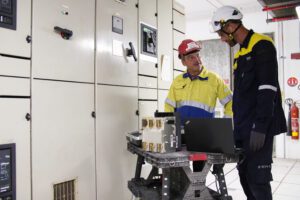Manufacturing facility electrical distribution system failures are often current or voltage-related events leading to stalled production, equipment damage, and even worker injury or fatality. For these reasons, proper electrical system documentation management ̶ including electrical single-line diagrams ̶ is paramount to help mitigate safety risks and minimize downtime.

However, typical methods, such as paper-based electrical single-line diagrams previously used to manage electrical distribution system technical documentation, have become obsolete. Today, changes in the nature of the workplace and the availability of next-generation digital twin software and tools have modified the landscape of electrical system maintenance and services.
But how?
A local team of engineering experts traditionally completes technical-level electrical system documentation on-site. Each time systems are switched on, off, or maintained, the electrical single-line diagrams serve as the point of reference for a safe human-to-system interface.
Unfortunately, operating expense (OpEx) reductions, an increase in retirements, and new workplace trends (e.g., mobile workforces) make far fewer on-site technical experts available to maintain these electrical system documents.
For example, one of my customers recently discovered how critical access and single-line diagram interpretation was to the uptime of his operations. His head electrical engineer had retired, and an issue of unexplained electrical faults kept taking down one of the manufacturing lines. The only single-line diagram appeared outdated and did not reflect recent changes to the manufacturing line. Outside experts were brought in at a high cost to troubleshoot the situation and address the issue.
In addition, electrical systems are upgraded and altered much more often due to dynamic marketplace demands and competitive pressures in today’s work environments. It is not uncommon for most plants to implement significant electrical system changes (which often accompany manufacturing line changes) every 3 to 5 years. As a result, the risk of out-of-date electrical documentation multiplies.
The power grids feeding manufacturing sites are also transforming. Upstream electrical system changes (such as integrating renewable energy sources) directly impact the plant site’s electrical systems. As a result, multi-source systems require updated on-site technical information to plan maintenance activities safely. Most local standards and regulations emphasize and mandate the availability, at all times, of updated versions of the single-line diagrams on site within the building.
Electrical Digital Twin Service offers a single source of the truth
Some manufacturing firms turn to third-party consulting firms in response to these challenges. Unfortunately, many of these firms rotate their resources across accounts can’t possess the institutional knowledge of the on-site experts who operated these systems for decades. When different electricians are dispatched to a site each time an issue occurs, it is difficult for them to ascertain whether the single-line diagrams are, in fact, current. As a result, risks of injury or unanticipated downtime increase dramatically when performing maintenance or updates.
So how can these risks be alleviated?
Schneider Electric and their partner ETAP (a leader in developing electrical digital twin software) have a long history of experience deploying plant electrical distribution systems and developing software and services that enable new methods for managing electrical systems. Together, digital twins create existing electrical network characteristics and topology that can simulate the impact of changes to a plant’s electrical system.
In collaboration with ETAP, Schneider Electric’s Electrical Digital Twin Service fosters a higher level of learning and helps minimize risks when operating and implementing electrical system changes. Using ETAP software, this service digitizes the paper-based electrical single-line diagrams. It leverages digital twins to manage the electrical network and offers a multi-year maintenance contract. Annual reviews by Schneider Electric consultants serve to document site electrical system changes and update the model throughout the entire contract lifecycle.
The service offers off-line and real-time simulation studies to help improve electrical network efficiency, resiliency, safety, and tackle the new challenges surrounding digitization and sustainability. More easily identifying the root cause of system downtime can reduce OpEx to influence overall organizational profitability.
Plant Operators benefit from higher safety and lower costs
Deploying the Electrical Digital Twin Service creates several advantages for plant operators:
- Lower risk of accidents and unplanned downtime – Out-of-date single-line diagrams are a risk to operators. If they inadvertently switch off the wrong device, they could trigger an unplanned downtime. There is also an increased risk that live parts of the system are unknowingly exposed, posing a danger of physical injury. By enriching the virtual twin model with accurate site data, cable details, and protection settings, tasks such as site operations are rendered safer and more precise.
- Single platform with integrated applications – The unique software enables multiple stakeholders to view consistent AD and DC plus LV to HV parameters, and for plant staff and power system experts to visualize the single-line diagrams in a way that facilitates electrical system studies (such as integration of EVs, PV panels, or new manufacturing lines).
- Higher sustainability solution – The digital twin services approach removes 40 to 50% of the expense of conducting electrical system studies by eliminating the overall cost of data collection and its associated carbon footprint.
An electrical digital twin can act either as an on-premise virtual model or a cloud-based solution. It enables end users to access a single source of the truth surrounding electrical equipment data. It features advanced applications such as virtual commissioning (viewing test control logic via operator graphical interface). This helps minimize potential errors and streamline electrical system startup, maintenance or shut down processes. Plant operators can now more accurately pinpoint where to make efficiency gains and where to avoid instances of downtime.
Visit our website to learn more about how the Electrical Digital Twin Service approach to managing electrical system updates and circuit coordination can reduce costs and enhance safety.



